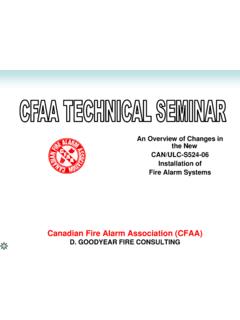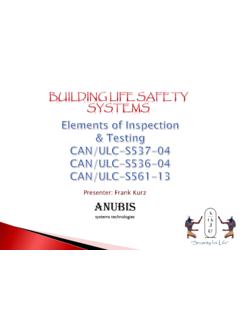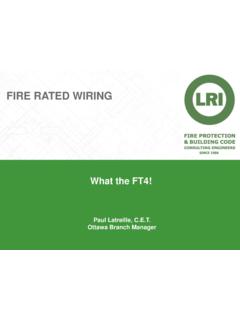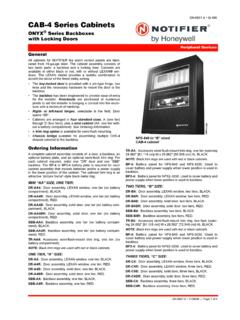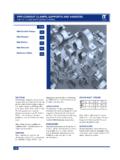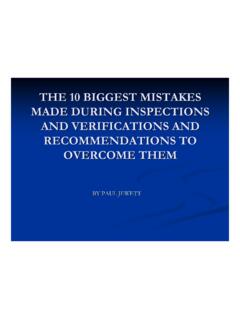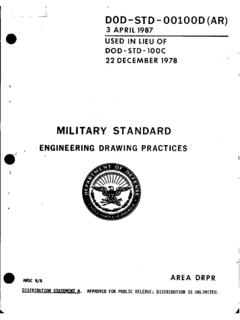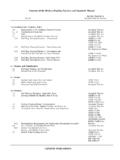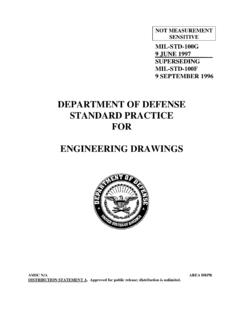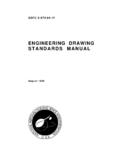Transcription of Fire Alarm Engineering Best Practices - CFAA
1 fire Alarm Engineering best Practices CFAA NCA Technical Seminar 2014. 2. fire Alarm Engineering best Practices Overview Code Compliance Equipment Selection and Layout Drawings, Specifications Commissioning and Acceptance Miscellaneous Goals To give attendees a wider view of issues affecting fire Alarm Engineering To share best Practices To engage in conversation that allows us to share our experience Format Open format. Questions and comments are welcome during the presentation. 3. fire Alarm Engineering best Practices Code Compliance 2012 Ontario Building Code and/or 2010 National Building Code of Canada Standards Referenced CAN/ULC S524 Standard for the Installation of fire Alarm Systems . - Latest issue is 2014. CAN/ULC S537 Standard for the Verification of fire Alarm Systems . - Latest issue is 2013. Sections will be covered as we discuss specific components Use the latest version Notwithstanding which version is referenced by the Building Code Don't mix and match.
2 Pick either the referenced version or the latest version in its entirety. 4. fire Alarm Engineering best Practices ULC S524 Standard for the Installation of fire Alarm Systems . The 2014 version has a number of new topics including: - Wireless devices - Expanded information on fault isolation - Suppression releasing equipment A large portion of the material intended to be presented here as best practice' is in the new version of the standard. Details of the updated standard is the subject of the next seminar. Providing features required where large scale systems are installed should be considered even for smaller systems. - The benefits usually outweigh the costs. 5. fire Alarm Engineering best Practices Equipment Selection and Layout Topics Covered Display and Control Equipment - Control Panels - Annunciators - Power Supplies - Communications Initiating Devices Signalling Devices Control Devices 6.
3 fire Alarm Engineering best Practices Equipment Selection and Layout Display and Control Equipment - Annunciators - Multi event display vs. zone indicators Let the complexity of the system decide More than 8 zones, use multi event display - Multiple annunciators Provide enough display equipment to allow for effective maintenance and event management Don't over do it. Where more than one display and control centre is installed, they shall have the ability to request, grant and deny system control with provision for fail- safe auto-transfer from one display and control centre to another. - Annunciator location Visible from the fire department entrance Specify display height for installation for the intended user (suggest m to centre of display). 7. fire Alarm Engineering best Practices Equipment Selection and Layout Display and Control Equipment - Annunciators - Zoning fire Alarm zone and fire Alarm circuit not necessarily the same thing.
4 Zoning defined by OBC article Circuit may serve multiple zones Determine the system zoning, then determine circuit routing Isolator modules required to provide zoning requirements for addressable circuits serving more than one zone. 8. fire Alarm Engineering best Practices Equipment Selection and Layout Display and Control Equipment - Control Panels - Single panel Locate at main entrance to reduce cost for annunciator. - Multiple panels Locate in stacked electrical rooms for improved fire protection of communications trunk. If two stacked sets of service rooms are available, consider class A wiring with panels located alternately in each riser room. LARGE SCALE NETWORK SYSTEMS. Each control unit and transponder shall be located in a suitable service room and/or central Alarm and control facility, separated from the remainder of the building by a minimum 1 h fire separation. 9. fire Alarm Engineering best Practices Equipment Selection and Layout Display and Control Equipment Network Communications - DCLB, DCLA, DCLC.
5 Why choose anything but the most fault tolerant required for large scale systems despite the size of the system? - Redundant communication method Addressable loop from the DCC/CACF to each transponder with monitor and relay modules to provide near full operation even in degrade mode. 10. fire Alarm Engineering best Practices Equipment Selection and Layout Display and Control Equipment Power Supplies - Systems are being provided with larger power supplies to accommodate more visual devices, voice communication systems etc. - Remote power supplies are still the go-to solution for some equipment suppliers. Increase system complexity but also flexibility Treat remote power supplies like transponders in terms of integrating them with the system (protection, supervision, testing etc.). Make power and battery calculations part of the normal submittal and review requirements. Make power supply and battery test data part of the acceptance criteria to ensure the remaining installed capacity is known when projects are completed.
6 A remote power supply serving a large scale network system shall be located in an electrical service room or a dedicated room separated from the remainder of the building by a 1 h fire separation. 11. fire Alarm Engineering best Practices Equipment Selection and Layout Initiating Equipment: - OBC and ULC S524 provide clear guidance to meet minimum requirements - Manufacturers do a good job of providing the latest technology available - Take a measured approach to detection device application Not taking advantage of current technology doesn't make sense as the benefits far outweigh the incremental cost Adding technology for the sake of it creates an overly complicated or sensitive system where it is not warranted or appreciated by the owner. - Consider multi-criteria detectors for everyday applications like electrical rooms, server rooms, public corridors - Consider air aspirating detectors for difficult to access locations like atriums or elevator shafts - Consider lower sensitivity smoke detectors for dirty locations where early detection is beneficial to property or life safety - Consider beam array devices for large open spaces with high ceilings, obstructions and the like such as power plants, chiller rooms, etc.
7 - Consider visual smoke detection for targeted detection in large open spaces to compliment other detection equipment. 12. fire Alarm Engineering best Practices Equipment Selection and Layout Initiating Equipment - Smoke detectors in high ceiling applications For ceilings up to 6 m in height, smoke detectors can be used with a reduced spacing of r Spot type smoke detector spacing is not required to be reduced for ceiling height, but may be affected by beam construction. On ceilings above 3600 mm in room height, spot type smoke detector spacing shall be based on fire type, growth rate, Engineering judgement and manufacturer's published installation instructions. - Smoke detectors in stair shafts Install at every 3rd level in any stair shaft serving 6 or more stories At worse the cost is one extra detector In exit stair shafts exceeding 18 m in height, measured from the lowest point to the highest point of the shaft, additional spot type smoke detectors shall be installed at every third floor.
8 13. fire Alarm Engineering best Practices Equipment Selection and Layout Initiating Equipment - Manual Stations Mounting heights used to be a problem to meet accessibility and ULC requirements but that has been resolved in the 2014 version of ULC 524. Install such that only one manual station is encountered along any egress pathway at the exit door. Manual stations shall be installed 1050 mm to 1150 mm above the finished floor level measured from the centre of the manual station. Q. Is it a manual station, a pull station or a manual pull station? 14. fire Alarm Engineering best Practices Equipment Selection and Layout Signalling Equipment - Strobes and Horns/Bells/Speaker spacing is different - Select low output devices for small rooms Don't count on sound transmission through walls to meet requirements Low output devices to not produce sound levels above maximum permitted values (100 dBA).
9 - Software for design to meet voice communication intelligibility. Algebraic equations can be used as well. Develop a library of layout patterns with acceptable results. T . S . *Last year's presentation 15. fire Alarm Engineering best Practices Equipment Selection and Layout Control Equipment - Relays Use remote relays when possible Reduces fire protection requirements for certain cables Improves supervision of controlled equipment - Smoke Management Often done by BAS system but should be by FAS. Very few BAS systems are listed for smoke control functions Have the BAS relinquish control of equipment on fire Alarm but allow the BAS control the return to normal operation after a fire event Where complicated control sequences are required involving system feedback, connect the FAS directly to the fan controller 16. fire Alarm Engineering best Practices Drawings and Specifications Separate fire Alarm from other electrical drawings whenever possible - Combine reflected ceiling (lighting) and floor plan (power) into one Show interference elements from other systems - Diffusers, Bulkheads, Ceiling Heaters Coordinate notes with specification items - Eliminates duplication or worse contradictory information Drawing specifications or book specifications - Let the project complexity decide but don't mix and match Show zone boundaries and provide a zone schedule Provide a riser schematic for network communications Provide a sequence of operations chart for complicated signalling or automated smoke management.
10 Don't ask for anything you don't want or need and check to ensure you get all of the items that you have asked for. 17. fire Alarm Engineering best Practices Commissioning and Acceptance Annunicators - Check communication between annunciator and control equipment (especially when the annunciator is not a network node). Integrated commissioning - Plan early, develop checklists with specific test scenarios and expected results. - Don't start until verification procedures are complete Verification reports and acceptance testing - Insist on and become familiar with proper verification reports - Don't rely on a certificate as proof of compliance - Conduct your own acceptance testing Commissioning of Life Safety and fire Protection Systems (1) Where life safety and fire protection systems are installed to comply with the provisions of this Code or the fire Code made under the fire Protection and Prevention Act, 1997, the commissioning of these integrated systems must be performed as a whole to ensure the proper operation and inter-relationship between the systems.
